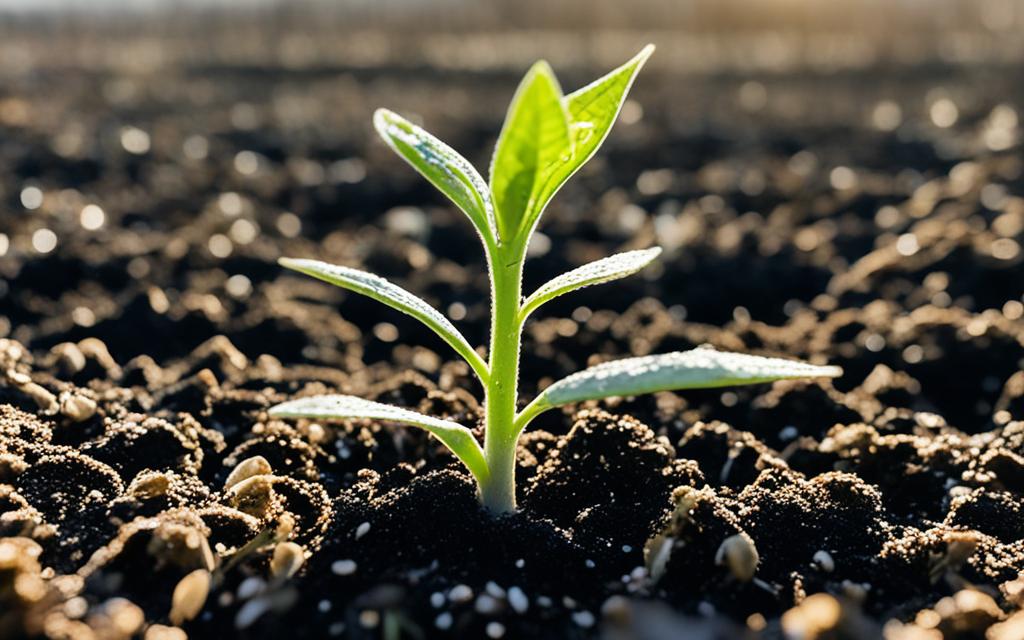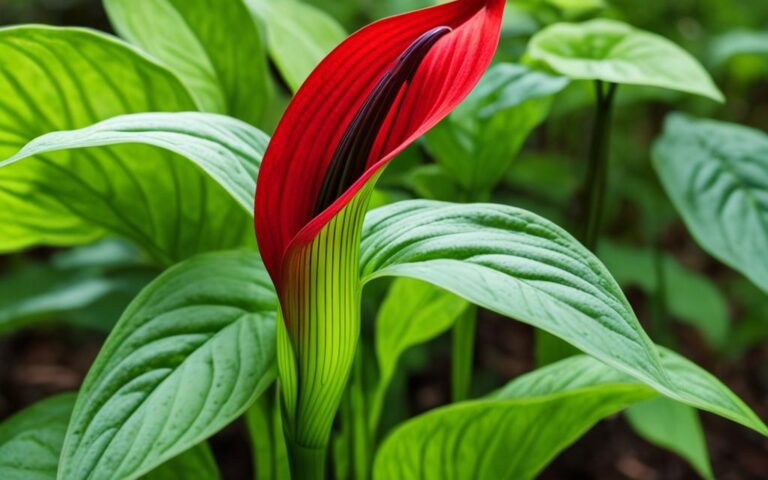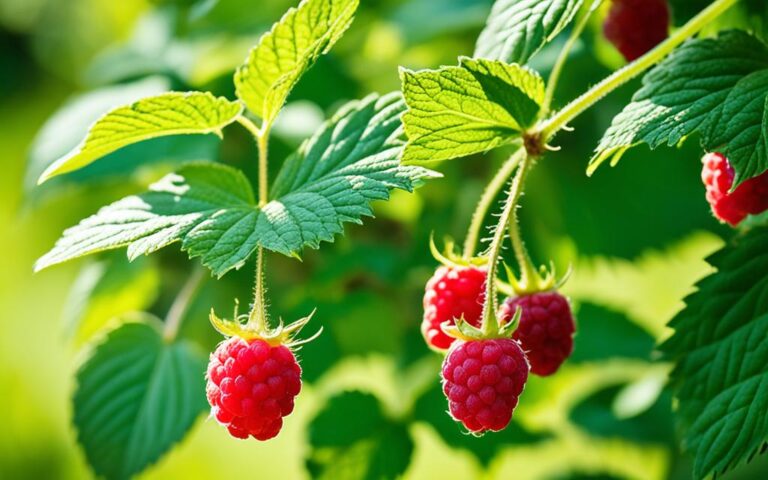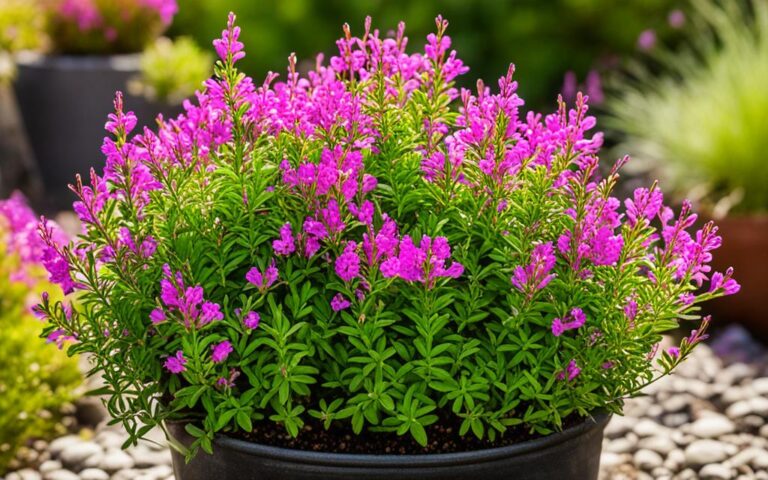Growing Sesame Seed Plants: A Complete Guide
Sesame seed is one of the oldest crops humans have grown, dating back over 3,000 years. It’s known for having the highest oil content among all seeds. This makes it a key crop in agriculture.
Sesame plants grow in many places, from the hot tropics of Tanzania to the dry lands of Sudan. They are loved by farmers and food lovers for their unique qualities.
Key Takeaways
- Sesame is one of the oldest oilseed crops, domesticated over 3,000 years ago.
- Sesame has the highest oil content among all seeds, making it a valuable agricultural commodity.
- Sesame plants are well-adapted to diverse climates, from tropical regions to arid zones.
- Sesame is an easy crop to cultivate, with equipment used for other crops applicable to sesame farming.
- Sesame is a profitable crop, offering more return for less cost compared to other crops.
Introduction to Sesame Seed Plants
Importance and Popularity
Sesame has been grown for over 3,000 years. It thrives in tropical areas worldwide and is prized for its seeds, packed with oil. Countries like Tanzania, Myanmar, India, and Sudan lead in sesame production.
This crop is versatile, used for seeds, oil, and more. It’s a favorite among farmers and consumers for its many uses.
In 2020, the world produced 7 million tonnes of sesame seeds. Sudan, Myanmar, and Tanzania were at the top. The U.S. grows sesame mainly through contracts with companies like Sesaco, which also offers special seeds. Sesame plants are self-pollinating and attract honeybees, creating top-quality honey.
Interesting Facts about Sesame
- Sesame is one of the oldest oilseed crops known and has the highest oil content of any seed.
- Sesame is remarkably drought-tolerant, growing in conditions where other crops fail.
- The seeds are produced in pods (seed capsules) that appear along the stem, with the first pods forming at the bottom and progressing upward.
- Archaeological evidence indicates sesame was domesticated in the Indian subcontinent at least 5500 years ago.
- Sesame seeds have been cultivated for over 4,000 years, originating from the Sunda Islands in Indonesia and spreading to China, Egypt, India, and Japan.
- Sesame seeds are rich in vitamin B1, dietary fiber, healthy fats, and various vitamins and minerals, making them a popular ingredient used for nutritional purposes.
Sesame is a unique and fascinating crop with a long history and many uses. Its importance and popularity keep growing, making it a valuable part of agriculture and cooking.
Common Sesame Seed Varieties
There are several types of sesame seed plants, each with unique traits and uses. The main ones are white sesame (Sesamum indicum) and black sesame (Sesamum radiatum).
White Sesame (Sesamum indicum)
White sesame, also known as hulled or benne, is the traditional type. It grows in tropical areas worldwide and is valued for its edible seeds. White sesame is loved for its mild, nutty taste and versatility.
Black Sesame (Sesamum radiatum)
Black sesame is similar to white sesame but comes from West and Central Africa. It has a deep color and has been grown there for ages. Black sesame can cross-pollinate with white sesame, creating seeds from white to black.
| Variety | Origin | Culinary Use | Nutritional Profile |
|---|---|---|---|
| White Sesame (Sesamum indicum) | Widely naturalized in tropical regions | Versatile, used in a variety of dishes | Rich in healthy fats, protein, calcium, and iron |
| Black Sesame (Sesamum radiatum) | West and Central Africa | Commonly used in Asian cuisines | Believed to have anti-aging benefits |
Both white and black sesame seeds have been key in global cooking for thousands of years. They bring unique tastes and health benefits to many dishes.
Anatomy of the Sesame Seed Plant
Sesame plants are fascinating and varied, with features that make them popular. They can grow 3-5 feet tall in dry areas, reaching up to 6 feet with good moisture and nutrients. The stem is square and leaves spread out from it.
The plant’s fruit is a capsule, like a pod, often called a pod. These pods split into sections, similar to a cotton boll. Some plants have one capsule per leaf, while others have three. Flowers start to bloom 35-45 days after planting and last until 75-85 days. The first pods grow 1-2 feet off the ground.
The sesame plant has many leaves but will self-defoliate as it matures. This means it drops its leaves naturally. This helps the plant save resources and ensures a good harvest of seeds.
| Sesame Plant Feature | Description |
|---|---|
| Height | 3-5 feet in dryland conditions, up to 6 feet in high moisture and fertility |
| Stem | Square-shaped, with leaves radiating outward |
| Fruiting Form | Capsule or pod, divided into sections, single or triple capsule per leaf axil |
| Flowering | Starts 35-45 days after planting, ends 75-85 days after planting |
| Leaf Shedding | Plant self-defoliates at maturity |
Knowing about the sesame plant anatomy and sesame plant structure is key for growing and enjoying this ancient crop.
Ideal Growing Conditions for Sesame Seed Plants
Preferred Light and Temperature
Sesame loves full sun and is a warm-season crop. It germinates best when the soil is about 70°F (21°C). Planting starts when the soil hits this temperature in spring.
Sesame likes warm, dry conditions. The latest planting is usually around the 4th of July.
Soil Requirements
Sesame does well on medium to light, well-drained soils with a pH of 5-8. It can’t handle salinity or waterlogging. A well-prepared seedbed is crucial for sesame seeds.
It can be planted using different methods like conventional, no-till, or raised beds.
Sesame has been grown since 1600 BC in the Tigris and Euphrates valleys. Now, it’s grown in Asia and Africa for its oil. In the U.S., Texas and Oklahoma are the main producers.
Sesame plants grow 2-3 feet tall and flower in late summer. Harvest takes about a month. Each plant can yield about 1/3 cup of seeds.
Sesame seeds are versatile and used in many dishes. They can be ground, pressed for oil, or eaten whole. They’re full of healthy fats and antioxidants like sesamol.
Propagating Sesame Seeds
Cultivating sesame seed plants starts with the right propagation steps. You can begin by sowing seeds indoors 4-6 weeks before the last frost. Then, move them outside after the spring frost has ended. Make sure to cover the seeds with a light layer of a sterile mix and keep it moist until they sprout. They germinate best at a soil temperature of 70°F (21°C).
Sesame plants thrive in hot, dry places and are often grown in deserts. Water the seedlings once a week until you move them outside. You can also directly plant sesame seeds in the garden when the soil gets warm, usually between Memorial Day and the 4th of July.
Sesame plants keep blooming and producing seeds until summer ends. From a 10-foot long, 2½ foot wide row, you can harvest about 425g (just under one pound) of seeds. However, the small size of the seeds means a 10-foot (3 m) row might only give you around 1 pound (0.5 kg) of seeds.
| Metric | Value |
|---|---|
| Optimal Soil Temperature for Germination | 21°C (70°F) |
| Seed Yield per 10-foot Row | Approximately 425g (just under 1 lb) |
| Seed Yield per 10-foot (3 m) Row | Around 1 pound (0.5 kg) |
It’s wise to save some extra seeds for sesame seed propagation next season. Sesame plants attract honeybees and help produce high-quality honey with their tubular flowers.
Starting and propagating sesame seeds correctly is key to a good harvest. By following these steps, gardeners can grow a lot of this versatile and nutritious oilseed.
Sesame Seed Plant Care and Maintenance
Sesame plants are easy to care for and don’t need much pruning or training. They keep blooming and producing seeds until summer ends. These plants grow upright by themselves, so you don’t need to support them.
Pruning and Training
No special pruning or training is needed for sesame plants. They grow upright, reaching 1-3.5 feet tall. Just make sure they get enough sunlight and keep them weed-free.
Pest and Disease Management
Sesame plants are pretty tough against pests and diseases. The varieties grown in main areas face few problems. Only a few herbicides like clethodim (Select) and glyphosate (RT3) are allowed for sesame. Weeding can be done 3-4 weeks after planting.
Some pests like aphids, leafhoppers, thrips, cutworms, and leaf rollers might bother sesame plants. Diseases such as blights can happen but aren’t a big deal. Using organic pest control helps keep the ecosystem balanced.
“Sesame is relatively tolerant of pests and diseases compared to other crops.”
Benefits of Growing Sesame Seed Plants
Growing sesame seed plants has many benefits for farmers. It’s a tough and versatile crop that does well in tough conditions. Sesame can handle drought and heat better than many crops, like grain sorghum and corn. This means it uses less water, which is great for areas with little water.
Sesame plants are also strong against diseases and pests. They need little upkeep and use fewer pesticides. This makes sesame a smart choice for farmers looking to make more money with less effort.
But sesame’s good points don’t stop after the harvest. Adding sesame to crop rotations can fight nematodes and improve soil health. This leads to better yields and lower costs for other crops. Sesame is truly a remarkable plant that offers a wealth of advantages for savvy growers.
| Benefit | Details |
|---|---|
| Drought and Heat Tolerance | Sesame requires 66% less water than grain sorghum and 75% less water than corn, making it an excellent choice for dry climates. |
| Disease and Pest Resistance | Sesame plants demonstrate exceptional tolerance to a wide range of diseases and pests, reducing the need for costly pesticides. |
| Improved Soil Health | Incorporating sesame into crop rotations can help suppress nematodes and enhance overall soil properties, leading to increased yields for subsequent crops. |
| Profitability with Limited Resources | Sesame’s resilience and versatility allow growers to achieve higher returns with fewer inputs, making it a more profitable choice than many other crops. |
The benefits of growing sesame seed plants are many and clear. From its ability to handle drought and heat to fighting diseases and pests, sesame is a top choice for farmers. By using sesame, farmers can make more money and grow crops in a sustainable way. This leads to a brighter future for farming.
“Sesame is truly a remarkable plant that offers a wealth of advantages for savvy growers.”
Maximizing Sesame Seed Plant Yields
Getting the best yields from sesame seeds is key for growers. To do this, they need to focus on the right growing conditions, plant spacing, and nutrient balance.
Sesame loves deep, fertile soil and full sun. It’s usually planted at 2.5 to 4.5 lbs per acre. Starting with 25 to 35 seeds per foot is a good idea.
Studies show the best yields come from row spacings of 32 cm to 50 cm. Having 300,000 plants per hectare is vital for high yields and controlling weeds.
Getting the nutrients right is also important for sesame. It does well with NPK fertilizers, especially when it’s flowering. For new soil, use 30 kg/ha of phosphorus and sulphur. For land that’s been farmed before, use 10-20 kg/ha.
The best time to plant sesame is usually from early to mid-January in many places.
| Key Factors for Maximizing Sesame Yields | Optimal Ranges |
|---|---|
| Planting Rate | 2.5 to 4.5 lbs per acre (25 to 35 seeds per foot) |
| Row Spacing | 32 cm to 50 cm |
| Plant Population | 300,000 plants per hectare |
| Fertilization | 30 kg/ha P and S in virgin soil, 10-20 kg/ha in previously cropped soil |
| Sowing Time | Early to mid-January |
By focusing on these key factors, sesame growers can boost their yields. The right growing conditions, planting, and nutrition are key to high sesame production.
Planting and Spacing Sesame Seed Plants
When growing sesame seed plants, getting the planting and spacing right is key. You can plant sesame using row planters or drills. The rows should be 15 to 40 inches apart. Place the seeds 1/2 to 3/4 inch below the soil’s moisture line, with a thin layer of dry soil on top.
The best depth for planting is 3/4 to 1.5 inches. For new growers, aim to plant 3 to 3.5 lbs of seeds per acre. Keep the plants 12 to 15 inches apart in the rows. This lets them get enough sunlight, nutrients, and air, which they need to grow well.
- Optimal row spacing for sesame plants: 15 to 40 inches
- Planting depth: 3/4 to 1.5 inches
- Planting rate: 3 to 3.5 lbs per acre for first-time growers
- Spacing within rows: 12 to 15 inches
Getting sesame planting and sesame spacing right is crucial for a healthy sesame crop. By following these tips, growers can help their sesame plants grow well and get a good harvest.
“Sesame is a resilient and adaptable crop that can thrive in a variety of growing conditions, but proper planting and spacing are key to unlocking its full potential.”
The Sesame Seed Plant Lifecycle
Sesame plants have a life cycle that is both interesting and important. They go through several phases, each with its own needs. Knowing about these phases helps farmers grow more sesame plants successfully.
The lifecycle of sesame plants includes four main stages: the vegetative phase, the pre-reproductive phase, the reproductive phase, and the ripening phase. Each stage has its own characteristics and needs. Farmers must pay attention to these to get a good harvest.
- Vegetative Phase (37 days): This phase starts with germination and ends with the plant growing its leaves and roots. It’s crucial for the plant to get strong roots and leaves early on.
- Pre-Reproductive Phase (38-44 days): As the plant grows, it starts to form buds. This is a key time for the plant to get ready for making seeds.
- Reproductive Phase (45 days+): In this phase, the plant blooms and makes capsules that hold the sesame seeds. The plant keeps growing and making seeds during this time.
- Ripening Phase (95-110 days): By 95 to 110 days, the sesame plants are ready to be harvested. This is when about 75% of the seeds on the main stem are mature.
Growers need to watch their sesame plants closely throughout their lifecycle. They should give them the right care, water, and food. Knowing about each growth stage helps farmers make the best choices. This way, they can grow more sesame plants and get a good harvest.
| Growth Stage | Duration (Days) | Key Characteristics |
|---|---|---|
| Vegetative Phase | 0-37 | Germination, emergence, seedling and juvenile stages |
| Pre-Reproductive Phase | 38-44 | First buds appear |
| Reproductive Phase | 45+ | Blooming, capsule formation |
| Ripening Phase | 95-110 | Physiological maturity, 75% of capsules have mature seeds |
The sesame plant lifecycle is full of interesting steps. Each step is important for a good harvest. By understanding these steps, farmers can grow sesame plants well. They can enjoy the benefits of this valuable crop.
Water Requirements for Sesame Plants
Sesame plants are known for being very drought-tolerant. They need less water than many other crops like cotton, corn, and soybeans. But, they do need enough moisture to grow well. The best way to water them is with a heavy soaking before and quick, light waterings during the growing season.
Too much water can harm sesame plants because they don’t like standing water. How much water and fertilizer they need depends on the local rainfall. For areas with less than 28 inches of rain a year, sesame needs 25-35 units of nitrogen per acre. If you irrigate them, they might need 60-80 units of nitrogen per acre to produce well.
| Sesame Water Requirement | Nitrogen Fertilizer Requirement |
|---|---|
| Dryland sesame (under 28 inches annual rainfall) | 25-35 units of nitrogen per acre |
| Fully irrigated sesame | 60-80 units of nitrogen per acre |
Sesame is one of the most drought-tolerant crops in the world. It’s great for growing in dry areas. With the right water and fertilizer, sesame farmers can get good yields from this tough and versatile plant.
“Sesame is a crop that can thrive with minimal water, making it a valuable option for sustainable agriculture in water-scarce regions.”
Fertilizing Sesame Seed Plants
Sesame is a deep-rooted crop that can find nutrients deep in the soil. But, it still needs balanced NPK fertilizers, especially when it flowers. To get the best sesame yields, using balanced NPK fertilizers is key.
Try applying half the nitrogen at the start of flowering. Sesame needs a lot of nitrogen during this time. The amount you need depends on the moisture, ranging from 25-35 units per acre for dryland sesame to 60-80 units per acre for irrigated sesame.
| Fertilizer | Nutrient Content | Recommended Application Rate |
|---|---|---|
| Single SuperPhosphate (SSP) | 19% P2O5 | 242.11 kg per hectare or 24.21 g per square meter |
| Muriate Of Potash (MOP) | 60% K2O | 20 kg per hectare or 2.0 g per square meter |
| Urea | 46% N | 40 kg N per hectare, applied in two splits |
Here’s how to apply these fertilizers:
- Urea goes with the first planting and again 4-6 weeks later.
- Single SuperPhosphate (SSP) is given once at planting because it doesn’t move much in the soil.
- Muriate Of Potash (MOP) gets split into two, once at planting and again during the first weeding.
Not all farmers have standard measuring tools. So, using body parts, 50kg fertilizer bags, everyday items, or basic farm tools can help estimate the right amount to apply.
“Sesame ranks sixth in the world production of edible oil seeds, producing approximately 3,312,986 million tons.”
Harvesting Sesame Seeds
Growing sesame sesame harvesting and sesame seed harvest are key steps. Sesame seeds take 78-85 days to grow before they’re ready. They turn from green to yellow to red when they’re fully ripe, usually 90 to 130 days after planting.
Getting the timing right is vital for a good sesame seed harvest. Harvest sesame seeds when they’re as dry as possible to avoid spoilage. They should have less than 10% moisture for storage to keep them fresh. Sesame seeds can last up to 5 years if stored properly.
Modern combines work well for sesame harvesting if set up right. The skill and experience of the operator are key. They must adjust the combine to reduce seed loss. Sesame seeds need to be dried to below 6% moisture before storage.
New sesame varieties that yield more and resist shattering have improved sesame seed harvest in the U.S. These varieties have helped overcome the issue of seed loss. With the right timing and equipment, growers can increase their sesame seed yields and have a successful harvest.
Sesame Seed Plant Byproducts and Uses
The sesame plant is more than just edible seeds. Its leaves and flowers can be eaten or used in sauces. The seeds can be toasted, pressed for oil, or turned into tahini paste.
Sesame oil is loved for its taste and health perks. It can have up to 50% oil. The plant’s leftover parts can stop soil from washing away. In some places, sesame is used for medicine, and its flowers make high-quality honey.
These sesame byproducts and sesame seed uses show how valuable this ancient crop is. It has been grown for over 5,000 years. Sesame is useful in many ways, from cooking to gardening.






